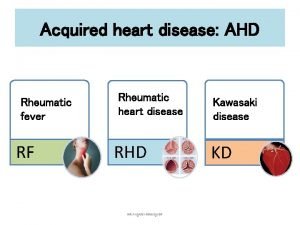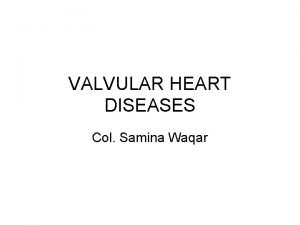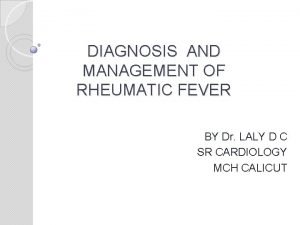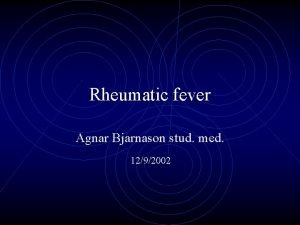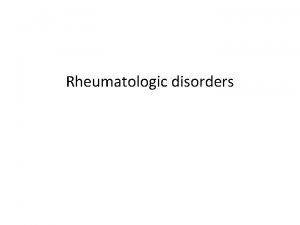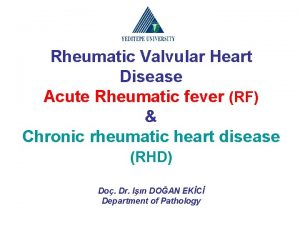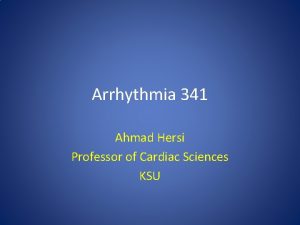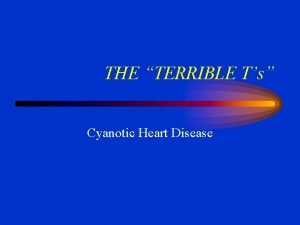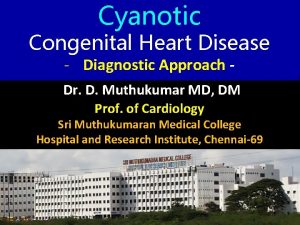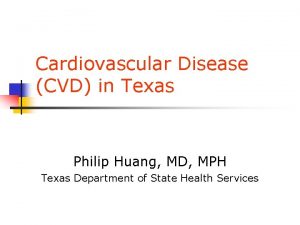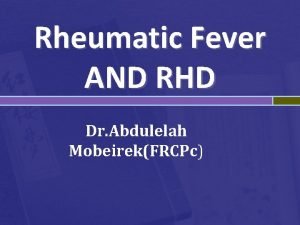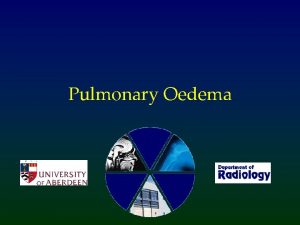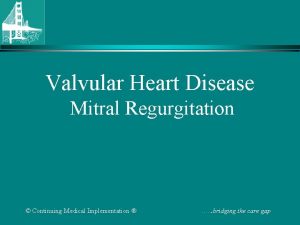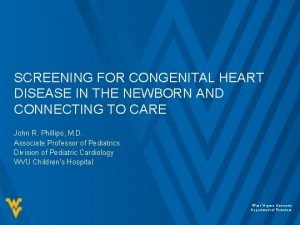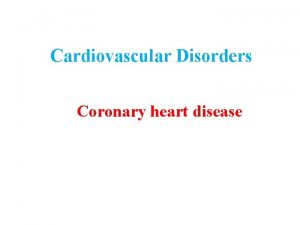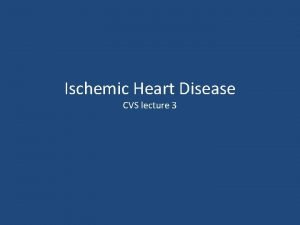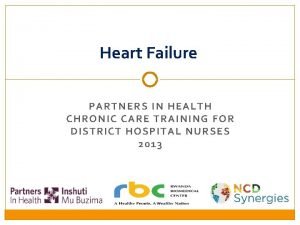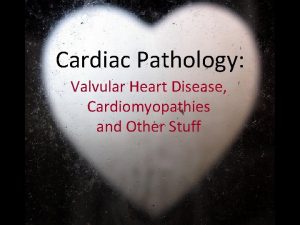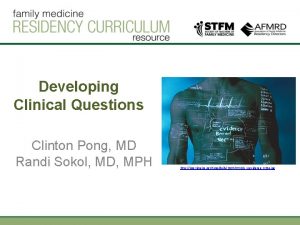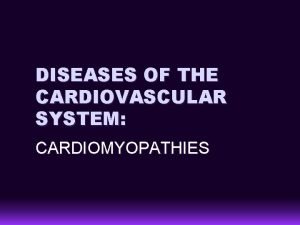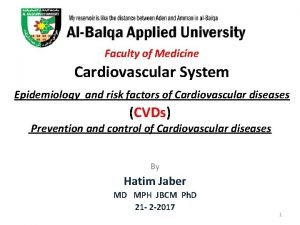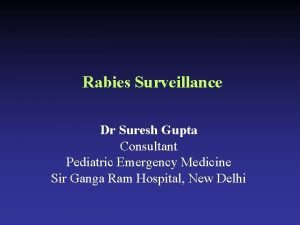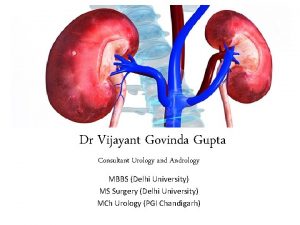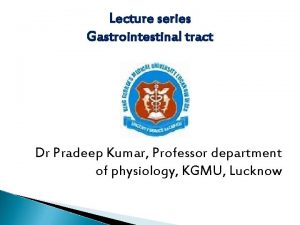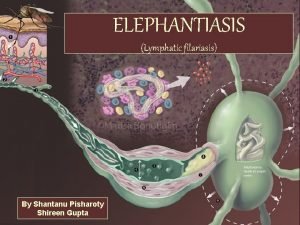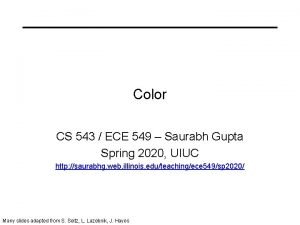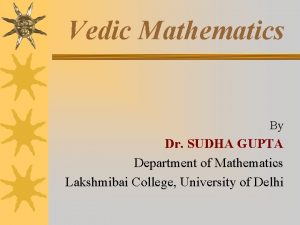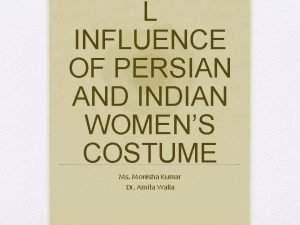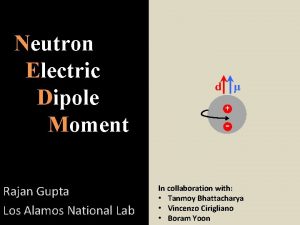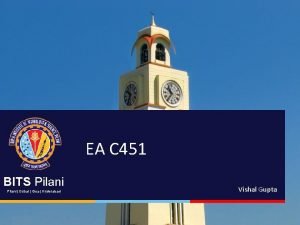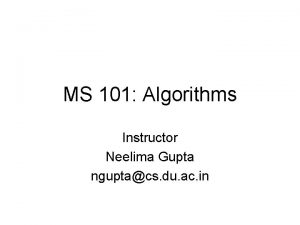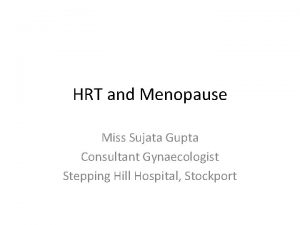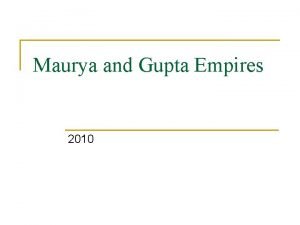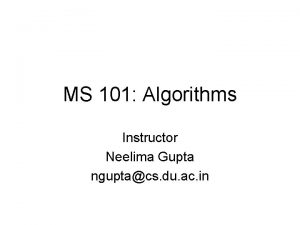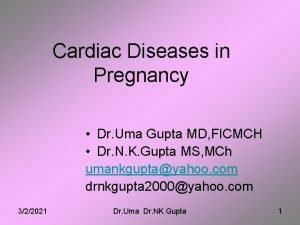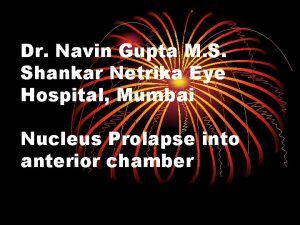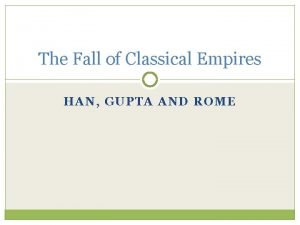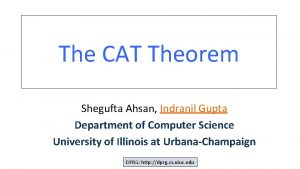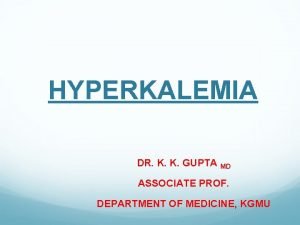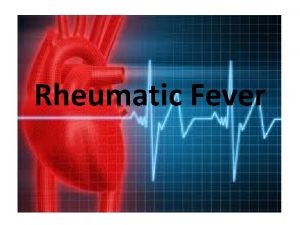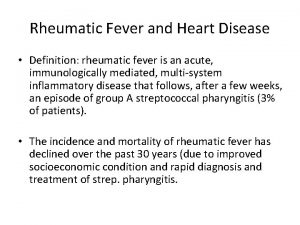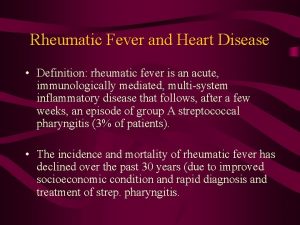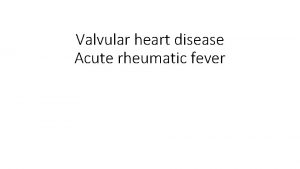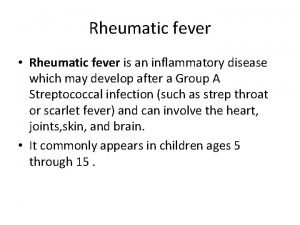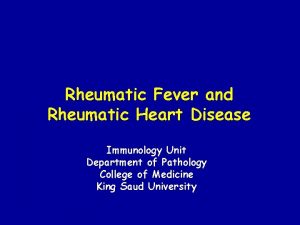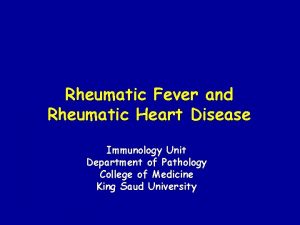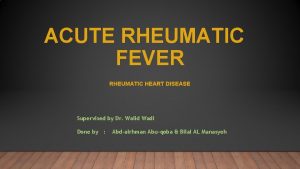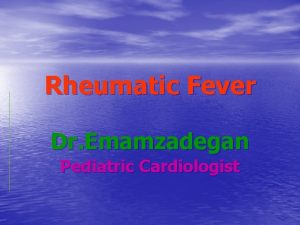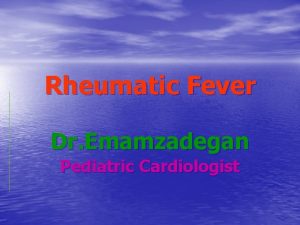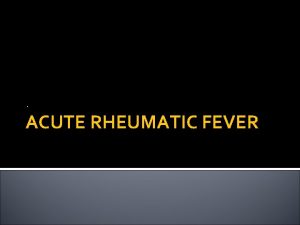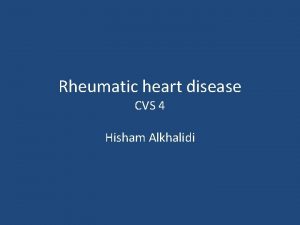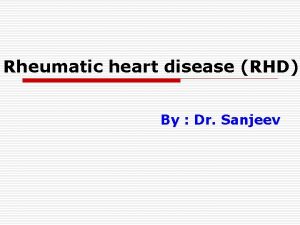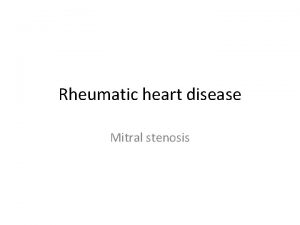RHEUMATIC FEVER RHEUMATIC HEART DISEASE Dr Sarika Gupta























































































- Slides: 87

RHEUMATIC FEVER & RHEUMATIC HEART DISEASE Dr Sarika Gupta (MD, Ph. D); Asst. Professor

ACUTE RHEUMATIC FEVER v v v Autoimmune consequence of infection (pharyngeal infection not the skin infection) with Group A beta haemolytic streptococcal infection Generalized inflammatory response affecting brains, joints, skin, subcutaneous tissues & the heart Modified Duckett-Jones criteria form the basis of the diagnosis of the condition

ACUTE RHEUMATIC FEVER Supporting evidences: v v About 66% of the patients with an acute episode of rheumatic fever have a history of an upper respiratory tract infection several weeks before The peak age (6 -15 yrs) & seasonal incidence of acute rheumatic fever closely parallel those of GABHS infections

ACUTE RHEUMATIC FEVER Features suggestive of GABHS infection Patient 5 to 15 years of age Presentation in winter or early spring Fever, Headache Sudden onset of sore throat Nausea, vomiting & abdominal pain; Pain with swallowing Beefy, swollen, red uvula Soft palate petechiae (“doughnut lesions”) Tender, enlarged anterior cervical nodes Tonsillopharyngeal erythema & exudates

ACUTE RHEUMATIC FEVER Redness & swelling of throat & tonsils; Beefy, swollen, red uvula; Soft palate petechiae (“doughnut lesions”) Sore throat: fever, white draining patches on the throat & swollen or tender lymph glands in the neck Tonsillopharyngeal erythema & exudates

ACUTE RHEUMATIC FEVER Supporting evidences: v Patients with acute rheumatic fever almost always have serologic evidence of a recent GABHS infection v Their antibody titers are usually considerably higher than those in patients with GABHS infections without acute rheumatic fever v Antimicrobial therapy against GABHS: prevents initial episodes of acute rheumatic fever & v Long-term, continuous prophylaxis: prevents recurrences of acute rheumatic fever

ACUTE RHEUMATIC FEVER Predisposing factors: v v v Family history of rheumatic fever Low socioeconomic status (poverty, poor hygiene, medical deprivation) Age: 6 -15 years

EPIDEMIOLOGY v v Prevalence of Acute rheumatic fever & RHD: 0. 67/1000 to 11/1000 children The INCIDENCE of rheumatic fever varies from 0. 2 to 0. 75/1000/ year in schoolchildren 5– 15 years of age (2001 Govt. Census)

certain M proteins (M 1, M 5, M 6, and M 19) share epitopes with human tropomyosin & myosin Common antigenic determinants are shared between components of GAS (M protein, protoplast membrane, cell wall group A carbohydrate, capsular hyaluronate) & specific mammalian tissues (e. g. , heart, brain, joint) strong correlation between progression to RHD & HLA-DR class II alleles & the inflammatory protein-encoding genes MBL 2 and TNFA Pathogenetic pathway for ARF & RHD

CLINICAL MANIFESTATIONS v v No pathognomonic clinical or laboratory finding for acute rheumatic fever Duckett Jones in 1944 proposed guidelines to aid in diagnosis & to limit overdiagnosis Jones criteria for the diagnosis of acute rheumatic fever 2 major criteria or 1 major & 2 minor criteria along with the absolute requirement There are 5 major and 4 minor criteria & an absolute requirement for evidence (microbiologic or serologic) of recent GABHS infection

DIAGNOSIS MAJOR MANIFESTATIONS MINOR MANIFESTATIONS Carditis Clinical features: Arthralgia Fever SUPPORTING EVIDENCE OF ANTECEDENT GROUP A STREPTOCOCCAL INFECTION****** -Elevated or increasing streptococcal antibody titer Polyarthritis Erythema marginatum Subcutaneous nodules Chorea Laboratory features: Elevated acute phase reactants: ESR, C-reactive protein Prolonged PR interval History of (<45 days) -Positive throat culture or rapid streptococcal antigen test or streptococcal sore throat or scarlet fever)

ARF & RHD First episode or Recurrence without established heart disease: 2 major criteria or 1 major & 2 minor criteria & the absolute requirement Recurrence with established heart disease: 2 minor criteria and the absolute requirement

MAJOR MANIFESTATIONS

Migratory Polyarthritis v v Most common (75%) Involves larger joints: the knees, ankles, wrists & elbows Rheumatic joints: hot, red, swollen & exquisitely tender (friction of bedclothes is uncomfortable) The pain can precede & can appear to be disproportionate to the other findings

Migratory Polyarthritis v v The joint involvement is characteristically migratory in nature Monoarticular arthritis is unusual unless anti inflammatory therapy is initiated prematurely, aborting the progression of the migratory polyarthritis

Migratory Polyarthritis v v v If a child with fever and arthritis is suspected of having acute rheumatic fever: withhold salicylates & observe for migratory progression A dramatic response to even small doses of salicylates is another characteristic feature of the arthritis Rheumatic arthritis is typically not deforming

Migratory Polyarthritis v v v Arthritis; earliest manifestation of acute rheumatic fever Correlate temporally with peak antistreptococcal antibody titers An inverse relationship between the severity of arthritis & the severity of cardiac involvement

Carditis v v v Carditis & chronic rheumatic heart disease: most serious manifestations of acute rheumatic fever Account for essentially all of the associated morbidity and mortality Occurs in 50% of patients Rheumatic carditis: pancarditis with active inflammation of myocardium, pericardium & endocardium Acute rheumatic carditis: tachycardia out of proportion to fever & cardiac murmurs, with or without evidence of myocardial or pericardial involvement

Carditis v v v Consists of either isolated mitral valvular disease or combined aortic & mitral valvular disease Valvular insufficiency: characteristic of both acute & convalescent stages of acute rheumatic fever Mitral regurgitation: a high-pitched apical holosystolic murmur radiating to the axilla In patients with significant mitral regurgitationassociated with an apical mid-diastolic murmur of relative mitral stenosis Aortic insufficiency: a high-pitched decrescendo diastolic murmur at the upper left sternal border

Carditis v v Valvular stenosis: appears several years or even decades after the acute illness However, in developing countries where acute rheumatic fever often occurs at a earlier age, mitral stenosis & aortic stenosis may develop in young children Moderate to severe rheumatic carditis: cardiomegaly & congestive heart failure with hepatomegaly & peripheral & pulmonary edema Myocarditis &/or pericarditis without evidence of endocarditis: rarely due to rheumatic heart disease

Carditis v v Echocardiographic findings: pericardial effusion, decreased ventricular contractility & aortic &/or mitral regurgitation The major consequence of acute rheumatic carditis is chronic, progressive valvular disease

During an episode of ARF, valve changes can be minor and are still able to regress After recurrent episodes of ARF, thickening of subvalvar apparatus, chordal thickening and shortening and progression to permanent valve damage is evident

Chorea v v v v St. Vitus’dance Sydenham chorea: 10 -15% of patients with acute rheumatic fever Often in prepubertal girls (8 -12 yrs) A long latency period (1 -6 mo) between streptococcal pharyngitis & the onset of chorea Neuropsychiatric disorder Neurologic signs: choreic movement & hypotonia Psychiatric signs: emotional lability, hyperactivity, separation anxiety, obsessions & compulsions

Chorea v v Begins with emotional lability & personality changes (poor school performance) Replace in 1 -4 weeks by characteristic spontaneous, purposeless movement of chorea (lasts 4 -8 months) followed by motor weakness Exacerbation by stress & disappearing with sleep are characteristic Elevated titers of “antineuronal antibodies” against basal ganglion tissues have been found in over 90% of patients

Chorea v Clinical maneuvers to elicit features of chorea include (1) demonstration of milkmaid's grip (irregular contractions of the muscles of the hands while squeezing the examiner's fingers) (2) spooning and pronation of the hands when the patient's arms are extended (3) wormian darting movements of the tongue upon protrusion (4) examination of handwriting to evaluate fine motor movements

Chorea v v Diagnosis: based on clinical findings with supportive evidence of GABHS antibodies In patients with a long latent period: antibody levels may have declined to normal SUBCLINICAL CARDITIS-30% Although the acute illness is distressing, chorea rarely, if ever, leads to permanent neurologic sequelae

Erythema Marginatum v v v A rare (<3% of patients with acute rheumatic fever) but characteristic rash of acute rheumatic fever It consists of erythematous, serpiginous, macular lesions with pale centers that are not pruritic It occurs primarily on the trunk & extremities, not on the face & it can be accentuated by warming the skin

Subcutaneous Nodules v v v A rare (≤ 1% of patients with acute rheumatic fever) finding Consist of firm nodules approximately 1 cm in diameter along the extensor surfaces of tendons near bony prominences A correlation between the presence of these nodules & significant rheumatic heart disease

MINOR MANIFESTATIONS

MINOR MANIFESTATIONS Clinical: v 1. Arthralgia (in the absence of polyarthritis as a major criterion) v 2. Fever (typically temperature ≥ 102°F & occurring early in the course of illness) Laboratory minor manifestations: v 1. Elevated acute-phase reactants (C-reactive protein, erythrocyte sedimentation rate, polymorphonuclear leukocytosis) v 2. Prolonged PR interval on electrocardiogram (1 st degree heart block)

ESSENTIAL CRITERIA An absolute requirement for the diagnosis of acute rheumatic fever is supporting evidence of a recent GABHS infection

Recent Group A Streptococcus infection Hallmarks of GAS sore throat: § High fever, tender anterior cervical lymph nodes § Close contact with infected person § Strawberry tongue, petechiae on palate § Excoriated nares( crusted lesions) in infants § Tonsillar exudates in older children § Abdominal pain GOLD STANDARD: POSITIVE THROAT CULTURE v

Recent Group A Streptococcus infection v v Acute rheumatic fever typically develops 2 -4 wk after an acute episode of GABHS pharyngitis at a time when clinical findings of pharyngitis are no longer present & only 10 -20% of the throat culture or rapid streptococcal antigen test results are positive Therefore, evidence of an antecedent GABHS infection is usually based on elevated or increasing serum antistreptococcal antibody titers

Recent Group A Streptococcus infection 1. ASO titre: v well standardized v elevated in 80% of patients with ARF v ASO titre of 333 Todd unit in children & 250 Todd unit in adults are considered elevated 2. Antideoxyribonuclease B titre: v ≥ 240 Todd unit in children & ≥ 120 Todd unit in adults

Recent Group A Streptococcus infection 3. Slide agglutination test (Streptozyme): v Detect antibodies against 5 different GABHS antigens v Rapidly, relatively simple to perform & widely available v Less standardized & less reproducible than other tests and should not be used as a diagnostic test for evidence of an antecedent GAS infection

Recent Group A Streptococcus infection v v v Single antibody measured: 80 -85% of patients have an elevated titer If 3 different antibodies (antistreptolysin O, anti. DNase B, antihyaluronidase) measured: 95 -100% have an elevation Therefore in suspected. ARF clinically: perform multiple antibody tests Diagnosis of ARF should not be made in patients with elevated or increasing streptococcal antibody titers who do not fulfill the Jones criteria True for younger, school-aged children having GABHS pyoderma or GABHS pharyngitis

DIFFERENTIAL DIAGNOSIS ARTHRITIS Rheumatoid arthritis Reactive arthritis (Shigella, Salmonella, Yersinia) Serum sickness Sickle cell disease Malignancy Systemic lupus erythematosus Lyme disease (Borrelia burgdorferi) Gonococcal infection (N. gnorrhoeae)

DIFFERENTIAL DIAGNOSIS CARDITIS Viral myocarditis Viral pericarditis Infective endocarditis Kawasaki disease Congenital heart disease Mitral valve prolapse Innocent murmurs

DIFFERENTIAL DIAGNOSIS CHOREA Huntington chorea Wilson disease Systemic lupus erythematosus Cerebral palsy Tics Hyperactivity

DIFFERENTIAL DIAGNOSIS v. Patients with infective endocarditis: present with both joint and cardiac manifestations v. These patients can usually be distinguished from patients with acute rheumatic fever by blood cultures & the presence of associated findings (hematuria, splenomegaly, splinter hemorrhages)

TREATMENT v v Ø Ø Bed rest Antibiotic Therapy: 10 days of orally administered penicillin or erythromycin or a single intramuscular injection of benzathine penicillin to eradicate GABHS from the upper respiratory tract Afterwards, the patient should be started on longterm antibiotic prophylaxis

TREATMENT v Ø Ø v Anti-inflammatory Therapy: Anti-inflammatory agents (salicylates, corticosteroids) should be withheld if arthralgia or atypical arthritis is the only clinical manifestation of presumed acute rheumatic fever Acetaminophen can be used Patients with typical migratory polyarthritis & with carditis without cardiomegaly or congestive heart failure: treatment with oral salicylates, 100 mg/kg/day in 4 divided doses PO for 3 -5 days, followed by 75 mg/kg/day in 4 divided doses PO for 4 -8 wk

TREATMENT v Ø Ø Patients with carditis & cardiomegaly or congestive heart failure: treatment with corticosteroids Prednisone 2 mg/kg/day in 4 divided doses for 2 -6 wk followed by a tapering of the dose that reduces the dose by 5 mg/24 hr every 2 -3 days. At the beginning of the tapering of the prednisone dose, aspirin should be started at 75 mg/kg/day in 4 divided doses to complete 12 wk of therapy

TREATMENT v v Supportive therapies for patients with moderate to severe carditis include digoxin, fluid & salt restriction, diuretics & oxygen The cardiac toxicity of digoxin is enhanced with myocarditis

TREATMENT Sydenham Chorea v Occurs after the resolution of the acute phase of the disease v Anti-inflammatory agents are usually not indicated v Sedatives: phenobarbital (16 -32 mg every 6 -8 hr PO) is the drug of choice v If phenobarbital is ineffective, then haloperidol (0. 01 -0. 03 mg/kg/24 hr divided bid PO) or chlorpromazine (0. 5 mg/kg every 4 -6 hr PO) should be initiated v Long-term antibiotic prophylaxis

PREVENTION PRIMARY-10 days course of penicillin therapy; about 30% of patients with acute rheumatic fever do not recall a preceding episode of pharyngitis SECONDARY-Secondary prevention is directed at preventing acute GABHS pharyngitis in patients at substantial risk of recurrent acute rheumatic fever

SECONDARY PREVENTION v Who should receive prophylaxis? Patients with documented history of rheumatic fever, including those with isolated chorea & those without evidence of rheumatic heart disease MUST receive prophylaxis

SECONDARY PREVENTION v For how long? CATEGORY DURATION Rheumatic fever without carditis At least for 5 yr or until age 21 year, whichever is longer Rheumatic fever with carditis but without residual heart disease (no valvular disease) At least for 10 yr or well into adulthood, whichever is longer Rheumatic fever with carditis & residual heart disease (persistent valvular disease) At least 10 yr since last episode & at least until age 40 yr; sometime lifelong

SECONDARY PREVENTION v What method of prophylaxis should be used? DRUG Penicillin G benzathine DOSE ROUTE 600, 000 U for children, ≤ 27 kg 1. 2 million U for children >27 kg, Intramuscular every 3 wk OR Penicillin V 250 mg, twice a day OR Oral 0. 5 g, once a day for patients ≤ 60 lb; 1. 0 g, once a day for Oral patients >60 lb For people who are allergic to penicillin and sulfonamide drugs Sulfadiazine or sulfisoxazole Macrolide or azalide Variable Oral

RHEUMATIC HEART DISEASE Rheumatic involvement of the valves & endocardium Ø The valvular lesions begin as small verrucae composed of fibrin and blood cells along the borders of one or more of the heart valves Ø The mitral valve is affected most often, followed in frequency by the aortic valve; right-sided heart manifestations are rare Ø At the end of inflammation: verrucae disappear & leave scar tissue Ø Repeated attacks of rheumatic fever: new verrucae form near the previous ones & the mural endocardium & chordae tendineae become involved Ø

MITRAL INSUFFICIENCY Backflow of blood from the LV to the LA during systole

MITRAL INSUFFICIENCY Pathophysiology: v Loss of valvular substance & shortening & thickening of the chordae tendineae v Because of the high volume load & inflammatory process, the left ventricle becomes enlarged v The left atrium dilates as blood regurgitates into this chamber v Increased left atrial pressure results in pulmonary congestion & symptoms of left-sided heart failure

MITRAL INSUFFICIENCY Clinical manifestations: v Exertion Dyspnea ( exercise intolerance), fatigue v Mild disease : NO signs of heart failure v Severe mitral insufficiency: signs of left sided heart failure v The heart is enlarged, with a forcible & hyperkinetic apical left ventricular impulse & often an apical systolic thrill v Soft S 1

MITRAL INSUFFICIENCY Clinical manifestations: v The 2 nd heart sound may be accentuated if pulmonary hypertension is present v A 3 rd heart sound is generally prominent v A holosystolic murmur is heard at the apex with radiation to the axilla v A short mid-diastolic rumbling murmur is caused by increased blood flow across the mitral valve as a result of the insufficiency

MITRAL INSUFFICIENCY Imaging studies: v ECG: prominent bifid P waves, signs of left ventricular hypertrophy & associated right ventricular hypertrophy if pulmonary hypertension is present v X-rays: prominence of the left atrium & ventricle; congestion of perihilar vessels, a sign of pulmonary venous hypertension v 2 D ECHO: enlargement of the left atrium & ventricle & Doppler studies demonstrate the severity of the mitral regurgitation

MITRAL INSUFFICIENCY Complications: v cardiac failure v chronic mitral insufficiency -right ventricular failure v atrial and ventricular arrhythmias

MITRAL INSUFFICIENCY Management: q Medical: v Prophylaxis against recurrences of rheumatic fever v Treatment of heart failure, arrhythmias and infective endocarditis v Afterload-reducing agents (ACE inhibitors or angiotensin receptor blockers): reduce the regurgitant volume & preserve left ventricular function

MITRAL INSUFFICIENCY Management: q Surgical: v For patients who despite adequate medical therapy have persistent heart failure, dyspnea with moderate activity & progressive cardiomegaly, often with pulmonary hypertension v Valve repair surgery preferred over valve replacement

MITRAL STENOSIS Obstruction of LV inflow that prevents proper filling during diastole ØNormal MV Area: 4 -6 cm 2 ØTransmitral gradients & symptoms begin at areas less than 2 cm 2 Ø

MITRAL STENOSIS Pathophysiology: v From fibrosis of the mitral ring, commissural adhesions & contracture of the valve leaflets, chordae & papillary muscles v It takes 10 years or more for the lesion to become fully established

MITRAL STENOSIS Pathophysiology: v Significant mitral stenosis results in increased pressure, enlargement & hypertrophy of the left atrium, pulmonary venous hypertension, increased pulmonary vascular resistance & pulmonary hypertension v Right ventricular hypertrophy & right atrial dilatation ensue & are followed by right ventricular dilation, tricuspid regurgitation & clinical signs of right -sided heart failure

MITRAL STENOSIS Clinical manifestations: v Correlation between symptoms & the severity of obstruction v Patients with mild lesions: asymptomatic v More severe degrees of obstruction: exercise intolerance & dyspnea v Critical lesions: orthopnea, paroxysmal nocturnal dyspnea, & overt pulmonary edema, as well as atrial arrhythmias

MITRAL STENOSIS Clinical manifestations: v Pulmonary hypertension: right ventricular dilatationfunctional tricuspid insufficiency, hepatomegaly, ascites & edema v Hemoptysis: rupture of bronchial or pleurohilar veins or by pulmonary infarction

MITRAL STENOSIS Clinical manifestations: v Jugular venous pressure is increased in severe disease with heart failure v prominent "a" wave in jugular venous pulsations: Due to pulmonary hypertension & right ventricular hypertrophy v Mild disease: heart size is normal, tapping apex v Severe mitral stenosis: moderate cardiomegaly v Cardiac enlargement massive: atrial fibrillation & heart failure v A parasternal right ventricular lift is palpable when pulmonary pressure is high

MITRAL STENOSIS Clinical manifestations: v Auscultatory findings: § Loud 1 st heart sound, § An opening snap of the mitral valve, and § A long, low-pitched, rumbling mitral diastolic murmur with presystolic accentuation at the apex § Murmur absent in patients with significant heart failure

MITRAL STENOSIS Clinical manifestations: § A holosystolic murmur secondary to tricuspid insufficiency § Pulmonary hypertension: pulmonic component of the 2 nd heart sound is accentuated § An early diastolic murmur: associated AR or pulmonary valvular insufficiency secondary to pulmonary hypertension

MITRAL STENOSIS Imaging studies: v ECG: prominent & notched P waves & varying degrees of right ventricular hypertrophy, Atrial fibrillation v X-rays: Left atrial enlargement & prominence of the pulmonary artery & right-sided heart chambers; calcifications may be noted in the region of the mitral valve v Severe obstruction is associated with a redistribution of pulmonary blood flow so that the apices of the lung have greater perfusion (the reverse of normal)

MITRAL STENOSIS Imaging studies: v 2 D ECHO: thickening of the mitral valve, distinct narrowing of the mitral orifice during diastole and left atrial enlargement v Doppler can estimate the transmitral pressure gradient v Cardiac catheterization quantitates § Diastolic gradient across the mitral valve § Allows for the calculation of valve area § Assesses the degree of elevation of pulmonary arterial pressure


MITRAL STENOSIS Management: q Medical: v Mild & moderate MS: anticongestive measures (digoxin & diuretics) v Atrial fibrillation: digoxin; procainamide for conversion to sinus rhythm in hemodynamiclly stable patients v chronic AF warfarin v IE prophylaxis v percutaneous mitral balloon valvotomy: failure to thrive with repeated respiratory infections

MITRAL STENOSIS Management: q Surgical: indicated in q patients with clinical signs & hemodynamic evidence of severe obstruction q or ANY SYMPTOMATIC Patient with NYHA Class III or IV Symptoms q or Asymptomatic moderate or severe MS with a pliable valve

MITRAL STENOSIS Management: v Surgical valvotomy or balloon catheter mitral valvuloplasty v Balloon valvuloplasty is indicated for symptomatic, stenotic, pliable, noncalcified valves of patients without atrial arrhythmias or thrombi

AORTIC INSUFFICIENCY Leakage of blood into LV during diastole due to ineffective coaptation of the aortic cusps ØRegurgitation of blood leads to volume overload with dilatation & hypertrophy of the left ventricle Ø


AORTIC INSUFFICIENCY Pathophysiology: v Combined pressure AND volume overload v v Compensatory Mechanisms: LV dilation & LV hypertrophy Progressive dilation leads to heart failure

AORTIC INSUFFICIENCY Clinical manifestations: v Symptoms are unusual except in severe aortic insufficiency v The large stroke volume & forceful left ventricular contractions result in palpitations v Sweating and heat intolerance are related to excessive vasodilation v Dyspnea on exertion can progress to orthopnea and pulmonary edema v Nocturnal attacks with sweating, tachycardia, chest pain, & hypertension

AORTIC INSUFFICIENCY Clinical manifestations: v Wide pulse pressure with bounding peripheral pulses v Systolic blood pressure elevated & diastolic pressure is lowered v Severe aortic insufficiency: enlarged heart with a left ventricular apical heave v Diastolic thrill unusual v Murmur begins immediately with the 2 nd heart sound & continues until late in diastole over the upper & midleft sternal border with radiation to the apex and upper right sternal border

AORTIC INSUFFICIENCY Clinical manifestations: v It has a high-pitched blowing quality & is easily audible in full expiration with the diaphragm of the stethoscope placed firmly on the chest & the patient leaning forward v An aortic systolic ejection murmur is frequent because of the increased stroke volume v An apical presystolic murmur (Austin Flint murmur) resembling MS is sometimes heard (due to the large regurgitant aortic flow in diastole preventing the mitral valve from opening fully)

Auscultatory and peripheral findings in severe AR

AORTIC INSUFFICIENCY Imaging studies: v ECG: signs of left ventricular hypertrophy & strain with prominent P waves in severe cases v X-rays: Enlargement of the left ventricle & aorta

AORTIC INSUFFICIENCY Imaging studies: v 2 D ECHO: v A large left ventricle & diastolic mitral valve flutter or oscillation caused by regurgitant flow hitting the valve leaflets v Doppler studies demonstrate the degree of aortic runoff into the left ventricle v Magnetic resonance angiography can be useful in quantitating regurgitant volume v Cardiac catheterization is necessary only when the echocardiographic data are equivocal

AORTIC INSUFFICIENCY Management: q Mild and moderate lesions are well tolerated. Unlike mitral insufficiency, aortic insufficiency does not regress q Medical: v Afterload reducers (ACE inhibitors or angiotensin receptor blockers) v Prophylaxis against recurrence of acute rheumatic fever v IE prophylaxis

AORTIC INSUFFICIENCY Management: v Surgical: Definitive Treatment v Surgical intervention (valve replacement) should be carried out well in advance of the onset of heart failure, pulmonary edema, or angina, when signs of decreasing myocardial performance become evident as manifested by increasing left ventricular dimensions on the echocardiogram

AORTIC INSUFFICIENCY Management: v Surgery is considered when early symptoms are present, ST-T wave changes are seen on the electrocardiogram, or evidence of decreasing left ventricular ejection fraction is noted v ANY Symptoms at rest v Asymptomatic treatment if: EF drops below 50% or LV becomes dilated

TRICUSPID VALVE DISEASE v v v Primary tricuspid involvement : rare Tricuspid insufficiency: secondary to right ventricular dilatation resulting from unrepaired leftsided lesions Signs: prominent pulsations of the jugular veins, systolic pulsations of the liver & a blowing holosystolic murmur at the lower left sternal border that increases in intensity during inspiration Signs of tricuspid insufficiency decrease or disappear when heart failure produced by the left-sided lesions is successfully treated Tricuspid valvuloplasty may be required in rare cases

PULMONARY VALVE DISEASE v v v Pulmonary insufficiency usually occurs on a functional basis secondary to pulmonary hypertension & is a late finding with severe mitral stenosis The murmur (Graham Steell murmur) is similar to that of aortic insufficiency, but peripheral arterial signs (bounding pulses) are absent The correct diagnosis is confirmed by twodimensional echocardiography and Doppler studies

SUMMARY Rheumatic heart disease is the only truly preventable chronic heart condition Primary prevention: Penicillin for suspected strep sore throat Secondary prevention Penicillin prophylaxis
 Preload and afterload
Preload and afterload Strepsore
Strepsore Rheumatic heart disease causes
Rheumatic heart disease causes Rheumatic heart disease
Rheumatic heart disease Vijaya's echo criteria
Vijaya's echo criteria Acute rheumatic fever
Acute rheumatic fever Rheumatic fever
Rheumatic fever Sarika peters
Sarika peters Roman fever setting
Roman fever setting Bharathi viswanathan
Bharathi viswanathan Heart disease
Heart disease Causes of valvular heart disease
Causes of valvular heart disease Terrible t's cyanotic heart disease
Terrible t's cyanotic heart disease Eisenmenger syndrome
Eisenmenger syndrome Superadded changes in coronary atherosclerosis
Superadded changes in coronary atherosclerosis Pathophysiology of valvular heart disease
Pathophysiology of valvular heart disease Heart disease data
Heart disease data Causes of valvular heart disease
Causes of valvular heart disease Heart disease
Heart disease Upper lobe blood diversion
Upper lobe blood diversion /watch?v=zpqlqsmpqt0
/watch?v=zpqlqsmpqt0 Footbal tatto
Footbal tatto Nursing assessment for congestive heart failure
Nursing assessment for congestive heart failure Pathophysiology of valvular heart disease
Pathophysiology of valvular heart disease Congenital heart disease pda
Congenital heart disease pda Heart disease symptoms
Heart disease symptoms Coronary heart disease
Coronary heart disease Pathophysiology of ischemic heart disease
Pathophysiology of ischemic heart disease Tet spell
Tet spell Tetralogy of fallot
Tetralogy of fallot Nyha class
Nyha class Pathophysiology of valvular heart disease
Pathophysiology of valvular heart disease Pathophysiology of valvular heart disease
Pathophysiology of valvular heart disease Pico question examples heart disease
Pico question examples heart disease Classification of antianginal drugs
Classification of antianginal drugs Dopamine uses
Dopamine uses Heart disease cat
Heart disease cat Cvds
Cvds Dullness to percussion
Dullness to percussion Goat heart dissection
Goat heart dissection Star plowhorse puzzle dog
Star plowhorse puzzle dog Dr suresh gupta ganga ram hospital
Dr suresh gupta ganga ram hospital Iiw 2018
Iiw 2018 Aseem gupta adq
Aseem gupta adq Dr pulin kumar gupta
Dr pulin kumar gupta Aarti gupta md
Aarti gupta md Dr vg gupta surgeon
Dr vg gupta surgeon Sunil gupta actor
Sunil gupta actor Define cell junction
Define cell junction How did chandragupta maurya begin building his empire?
How did chandragupta maurya begin building his empire? Cholegogue
Cholegogue Kate rayner
Kate rayner Shireen gupta
Shireen gupta Saurabh gupta uiuc
Saurabh gupta uiuc Fall of gupta empire
Fall of gupta empire Amit gupta microsoft
Amit gupta microsoft Gupta sculpture
Gupta sculpture Indias first empire
Indias first empire Dr sudha gupta
Dr sudha gupta Circle in computer graphics
Circle in computer graphics Gupta empire trade routes
Gupta empire trade routes Persian
Persian P-cp
P-cp Vishal gupta bits pilani
Vishal gupta bits pilani What is gupta empire known for
What is gupta empire known for Neelima gupta delhi university
Neelima gupta delhi university Dr sujata gupta
Dr sujata gupta Chandragupta maurya ruled for _____years.
Chandragupta maurya ruled for _____years. Kavita gupta md
Kavita gupta md Odu linux servers
Odu linux servers Dr uma gupta
Dr uma gupta Navin gupta md
Navin gupta md Shambhu gupta & co
Shambhu gupta & co Astronomy gupta empire
Astronomy gupta empire Shankar gupta
Shankar gupta Dr manish kumar gupta
Dr manish kumar gupta Dr abha gupta
Dr abha gupta Raghav gupta - wikipedia
Raghav gupta - wikipedia Han gupta
Han gupta Ccontention
Ccontention Advantages of surface computing
Advantages of surface computing Mauryan empire and gupta empire venn diagram
Mauryan empire and gupta empire venn diagram The maurya and gupta empires
The maurya and gupta empires Gupta empire philosophy
Gupta empire philosophy Vaani gupta
Vaani gupta Varna gupta
Varna gupta K+k
K+k Write the narration for gupta
Write the narration for gupta
